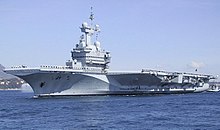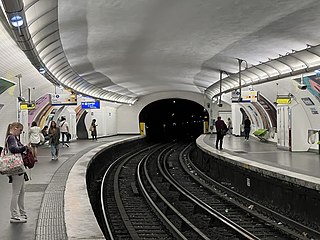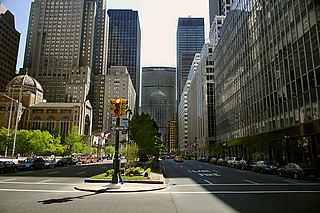

In France, and around the world, many things have been named after Charles de Gaulle.


In France, and around the world, many things have been named after Charles de Gaulle.
Many streets and public buildings in France bear the name of Charles de Gaulle. They include:
De Gaulle is also commemorated outside France, particularly in street names. These include:

The Place Charles de Gaulle, historically known as the Place de l'Étoile, is a large road junction in Paris, France, the meeting point of twelve straight avenues including the Champs-Élysées. It was renamed in 1970, following the death of President Charles de Gaulle. It is still often referred to by its original name; the nearby Métro and RER station retains the designation Charles de Gaulle–Étoile. Paris's Axe historique cuts through the Arc de Triomphe, which stands at the centre of the Place Charles de Gaulle.

The Avenue des Champs-Élysées is an avenue in the 8th arrondissement of Paris, France, 1.9 kilometres (1.2 mi) long and 70 metres (230 ft) wide, running between the Place de la Concorde in the east and the Place Charles de Gaulle in the west, where the Arc de Triomphe is located. It is known for its theatres, cafés, and luxury shops, as the finish of the Tour de France cycling race, as well as for its annual Bastille Day military parade. The name is French for the Elysian Fields, the place for dead heroes in Greek mythology. It has been described as the "most beautiful avenue in the whole world".

Les Sablons is a station on Line 1 of the Paris Métro in the commune of Neuilly-sur-Seine west of the city. In 2019 Les Sablons ranked 53rd in passenger volume among the system's 302 stations. The station is located under Avenue Charles de Gaulle, a major traffic artery between Etoile and La Defense. It has four entrances, a pair located on each of the medians on opposite sides of the Avenue.

Ternes is a station on Line 2 of the Paris Métro, under the Place des Ternes on the border between the 8th and 17th arrondissements.

Pasteur is a station on Line 6 and Line 12 of the Paris Métro in the 15th arrondissement. It is named after the French chemist Louis Pasteur. The platforms for both lines are situated underground, although Line 6 becomes elevated as it approaches northwest end of the station. Nearby are the Pasteur Institute and the Lycée Buffon (school).

Kléber is a station of the Paris Métro serving Line 6 at the intersection of Avenue Kléber and the Avenue des Portugais in the 16th arrondissement.

Trocadéro is a station on Line 6 and Line 9 of the Paris Métro in the 16th arrondissement. It serves and is named after the Place du Trocadéro.

La Motte-Picquet–Grenelle is a station of the Paris Métro, at the interconnection of line 6, line 8, and line 10 in the 15th arrondissement. The station combines underground and elevated platforms. It is a major métro interchange on the Rive Gauche, the biggest west of Montparnasse.

A boulevard is a type of broad avenue planted with rows of trees, or in parts of North America, any urban highway.

The Agency for French Education Abroad, or Agency for French Teaching Abroad,, is a national public agency under the administration of the Ministry of Foreign Affairs of France that assures the quality of schools teaching the French national curriculum outside France. The AEFE has 495 schools in its worldwide network, with French as the primary language of instruction in most schools.

Charles de Gaulle–Étoile station is a station on Line 1, Line 2 and Line 6 of the Paris Métro, as well as on Île-de-France's commuter rail RER A. It lies on the border of the 8th, 16th and 17th arrondissements of Paris. Originally called simply Étoile, after its location at Place de l'Étoile, it took on the additional name of President Charles de Gaulle in 1970.

Paris Métro Line 2 is one of the sixteen lines of the Paris Métro. Situated almost entirely above the former customs barrier around the capital, it runs in a semicircle in the north of Paris.
Charles de Gaulle (1890–1970) was a French military leader and statesman.